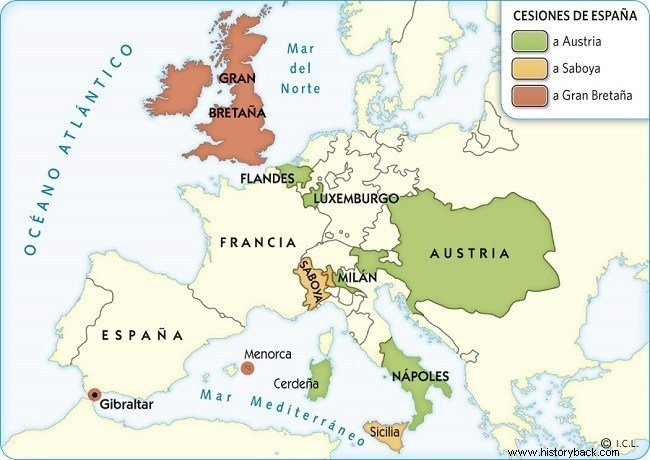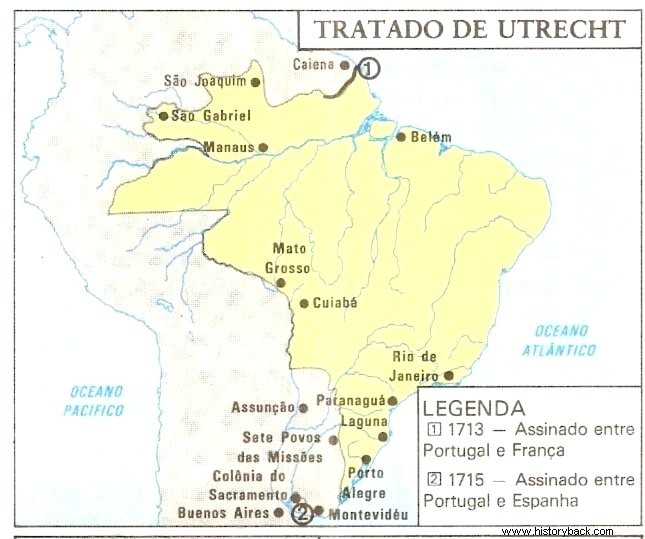The Treaty of Utrecht (1713-1715) were actually two agreements that ended the War of the Spanish Succession and changed the map of Europe and the Americas.
In the first Treaty, in 1713, Great Britain recognized the Frenchman Felipe de Anjou as King of Spain. For its part, Spain ceded Menorca and Gibraltar to Great Britain.
The agreement also had repercussions in America, as it established the borders between Brazil and French Guiana and defined the limits of Amapá.
The second Treaty of Utrecht, signed on February 6, 1715, this time between Portugal and Spain, re-established the possession of Colonia del Sacramento to Portugal.
Origin and Causes of the Treaty of Utrecht
In 1700, King Charles II (1661-1700) died in Spain, leaving no heirs.
In his will, he had indicated that the French infant Philip of Anjou would inherit the throne, as he was the grandson of a Spanish infanta and the French king Louis XIV.
However, countries like England imagined that Felipe de Anjou could crown himself, in the future, king of France and Spain. Added to the territories that Spain had in Europe and the Americas, this future kingdom would be a real power.
Likewise, Emperor Joseph I of the Holy Roman Empire and Archduke of Austria was also afraid of this happening. Thus, this emperor defended the candidacy of his brother Carlos for the Spanish throne.
Therefore, the “Hague Alliance” was formed with England and the Holy Empire. Later, in 1703, Portugal joined this association through the Treaty of Methuen.
On the other hand was France, ruled by Louis XIV and part of Spain. It should be noted that Spain was divided between supporters of France and the Holy Empire.
However, in 1711, the Hague Alliance was dissolved. This was because Emperor Joseph I died without heirs and Charles was elected Holy Roman Emperor.
For the British, especially, it was not convenient to have so much power concentrated in the hands of an Austrian monarch. Negotiations between France and Great Britain begin, in order to resolve the issue of Spanish succession.
Diplomatic discussions, begun in 1712, allowed the signing of peace agreements between England, France and Spain the following year:the Treaty of Utrecht.
Resolutions of the Treaty of Utrecht
To be recognized as King of Spain by England, Felipe de Anjou renounced the throne of France and ascended to the Spanish throne as Felipe V. With this, he also conserved the Spanish possessions in America.
However, it had to get rid of its territories in Europe and England received the maritime base of Gibraltar and the island of Menorca.
Great Britain gained the right to exploit for 30 years the trade in enslaved blacks to the Spanish colonies. Ironically, later on, several British associations would protest against the slave trade practiced by the British, starting the campaign for the abolition of slavery.
See also:End the African Slave TradeFrance and England
France managed to see its candidate for the Spanish throne confirmed and thus maintained the integrity of French territory.
In America, France managed to conserve the regions of Newfoundland and Acadia, both in Canada, which were contested by the British.
However, the British gained from France Hudson Bay in Canada and the island of Saint Kitts (Saint Kitts) in the Caribbean.
Consequences of the Treaty of Utrecht
The main consequence of the signing of the Treaty of Utrecht was the reshaping of the map of Europe and America.
Always with the objective of guaranteeing the throne to King Felipe V, Spain had to cede its European territories to several countries.
Through the agreements concluded in Utrecht, the regions comprising the south of the present-day Netherlands, Milanesado (Milan) and Naples were incorporated by Austria.
The Duchy of Savoy, on the Italian Peninsula, received Sicily, south of the same peninsula.
These diplomatic points were signed in 1714, in the so-called treaties of Rastatt, Barden and Antwerp.

France also loses its hegemony on the European continent, which will only be regained with Napoleon Bonaparte.
As for Great Britain, its territorial and commercial gains placed it as a nation of preponderance in the fields of naval, commercial and colonial exploration.
For Spain, the signing of the Treaty of Utrecht did not mean peace, because some regions, such as the kingdom of Aragon, did not recognize Felipe V as sovereign. Only in 1714, with the military defeat in Catalonia, this kingdom was definitively incorporated into the Kingdom of Castile and, in this way, form the Kingdom of Spain.
The European division and balance of power established in Utrecht would last almost a century and would again be replaced by the treaties signed at the Congress of Vienna (1814-1815).
See also:Independence of CataloniaSecond Treaty of Utrecht (1715)
The second Treaty of Utrecht was signed between the King of Spain, Felipe V and the King of Portugal, Dom João V, in 1715, in the same Dutch locality.
Spain returned to Portugal the Colonia del Sacramento, on the Rio de la Plata. In turn, Portugal ceded the municipalities of Albuquerque and Puebla de Sanabria to Spain.
Consequences of the Treaty of Utrecht for Brazil
The Treaty of Utrecht had repercussions for the territory of Portuguese America, Brazil.
In 1713, the borders between French Guiana and Brazil were established. In addition, it was recognized that the territory, in what is now the state of Amapá, belonged to the Portuguese Crown.

In the south, Colonia del Sacramento was returned to the Portuguese Crown. Later, still in the 18th century, Portugal and Spain would once again renegotiate the borders through the Treaty of Madrid (1750) and the Treaty of São Ildefonso (1777).
See also :Formation of the Brazilian territory
